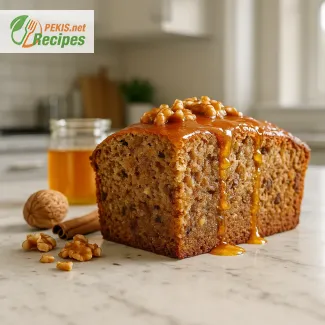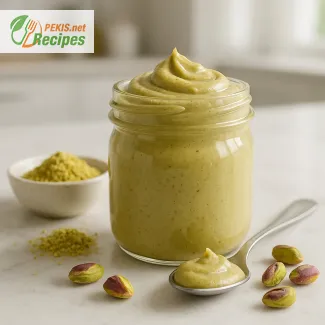Creamy layers of mascarpone, chestnut purée, and espresso-soaked ladyfingers create an elegant autumn dessert ready in 30 minutes with no baking required. This chestnut tiramisu cake serves 8 portions, combining the nutty sweetness of chestnuts with the rich aroma of coffee for a perfectly balanced treat. It’s best enjoyed chilled, as the flavors deepen after resting in the refrigerator, making it ideal for make-ahead desserts or festive gatherings. Light, smooth, and indulgent, it captures the cozy warmth of the season in every bite.
PEKIS – professional chef and recipe developer with over 25 years of experience in cooking and baking, specializing in European and international cuisine. Drawing on years of working with Italian pastries and seasonal desserts, this creation highlights the delicate harmony between mascarpone, espresso, and chestnuts. The combination was perfected through numerous autumn-inspired menus where balance and texture play the key role, ensuring every layer of this tiramisu cake feels refined, smooth, and deeply flavorful.

A velvety chestnut tiramisu cake inspired by Italian autumn flavors
The fusion of creamy mascarpone, espresso, and chestnut purée in perfect harmony
Delicate layers of mascarpone, chestnut purée, and espresso-soaked ladyfingers merge into a dessert that captures the comfort and elegance of autumn. The creamy texture of the chestnut layer adds natural sweetness and depth, while the espresso brings balance with its subtle bitterness. Together, they create a harmony that is both sophisticated and nostalgic — a dessert that feels indulgent yet grounded in the warmth of seasonal ingredients.
The key to this dessert lies in the quality and contrast of textures. Smooth chestnut purée adds a nutty undertone, while mascarpone gives a rich yet airy body. The espresso-soaked biscuits add structure and aroma, making every layer distinct but seamlessly connected. A light dusting of unsweetened cocoa powder finishes the dessert with a bittersweet edge that enhances its creamy profile.
A taste of Italy’s seasonal dessert tradition
In the heart of northern Italy, where chestnuts have long been considered a symbol of autumn abundance, generations of bakers transformed this humble nut into luxurious pastries. The marriage between chestnut cream and mascarpone originated as a way to celebrate the harvest season — a sweet nod to local produce and Italian craftsmanship. Over time, this pairing evolved into the modern chestnut tiramisu, combining the familiarity of coffee and the refinement of chestnut purée into one unforgettable dessert.
The texture, flavor, and scent together evoke cozy Italian evenings filled with the aroma of roasted chestnuts and freshly brewed espresso. Each spoonful feels like a connection between tradition and comfort, highlighting the artistry behind classic Italian patisserie.
Storing and make-ahead tips
The chestnut tiramisu cake tastes even better after a few hours of resting, as the flavors have time to blend and mature.
- Store in an airtight container in the refrigerator for up to 3 days.
- The cake should be kept well-chilled, as mascarpone cream holds its texture best when cold.
- For make-ahead preparation, assemble the dessert the day before serving — this allows the espresso and cream layers to fully infuse.
- Avoid freezing to preserve the delicate structure of mascarpone and chestnut purée.
Why you’ll love this recipe
- No baking required – ready in a fraction of the time, yet looks and tastes elegant.
- Seasonal and aromatic – ideal for autumn gatherings and cozy dinners.
- Rich but balanced – combines creamy, nutty, and coffee tones perfectly.
- Versatile for presentation – can be made in cups, jars, or as a full cake.
- Make-ahead friendly – even better after chilling overnight.
More autumn chestnut desserts to explore
If you love the comforting texture of chestnuts, discover these seasonal favorites available on pekis.net:
- Chestnut purée – silky no bake dessert ready in 20 minutes
- Chestnut panna cotta with vanilla sauce for autumn days
Both recipes share the same rich, velvety chestnut essence and pair beautifully with a cup of espresso or sweet dessert wine.
Creative variations for a personal touch
- Chocolate twist: Add a thin layer of melted dark chocolate between the mascarpone and chestnut layers for a deeper, more intense flavor.
- Nut infusion: Sprinkle crushed hazelnuts or almonds on top for added texture and aroma.
- Spiced version: Mix a pinch of cinnamon or cardamom into the espresso to emphasize its autumn character.
- Individual servings: Serve in dessert glasses for elegant single portions — ideal for dinner parties.
- Festive finish: Garnish with caramelized chestnuts or a drizzle of chocolate sauce for a refined presentation.
The sensory essence of the chestnut tiramisu cake
This dessert stands out for its creamy, layered texture and deep aroma. The chestnut’s subtle sweetness contrasts perfectly with coffee bitterness, creating a balance that feels indulgent but not heavy. The interplay of cold cream, soft biscuits, and fine cocoa provides an exceptional mouthfeel that lingers gently with every bite.
Every layer tells a story — the Italian roots, the autumn season, and the balance between texture and flavor. It’s an invitation to slow down, savor, and enjoy the best that seasonal ingredients can offer in one harmonious dessert.
- Prepare the coffee mixture: Brew the espresso and allow it to cool to room temperature. Add the dark rum and set aside.
- Whip the cream: In a chilled bowl, whip the heavy cream until soft peaks form. Do not overbeat.
- Prepare the mascarpone mixture: In another bowl, whisk mascarpone with powdered sugar and vanilla extract until smooth and creamy.
- Combine with chestnut purée: Add the chestnut purée to the mascarpone mixture and blend gently until a uniform cream forms. Fold in the whipped cream carefully to keep the mixture airy.
- Assemble the cake: Dip each ladyfinger briefly into the espresso-rum mixture, then layer them in a springform pan. Spread a generous layer of the chestnut-mascarpone cream on top. Repeat the layering until all ingredients are used, finishing with cream on top.
- Chill the cake: Cover and refrigerate for at least 4 hours, or overnight for best texture and flavor integration.
- Finish and serve: Before serving, dust the top with unsweetened cocoa powder and decorate with dark chocolate shavings. Slice carefully and serve chilled.
FAQ questionCan I use canned chestnut purée or do I need to make it from scratch?
Yes—sweetened canned chestnut purée works perfectly and keeps the texture silky and spreadable. If using unsweetened purée, add a little powdered sugar and vanilla to taste. The key is a smooth, lump-free consistency; press through a sieve if needed for a refined finish.
FAQ questionHow do I keep the mascarpone cream stable and not runny?
Start with cold mascarpone and cold heavy cream. Whip the cream to soft peaks, then gently fold it into the mascarpone–chestnut mixture to preserve air without overworking. If the mixture seems loose, chill it for 15–20 minutes; cold temps help the fats firm and stabilize.
FAQ questionHow long should I dip ladyfingers to avoid sogginess?
Work fast: 1–2 seconds per side in cooled espresso (with or without rum) is enough. You want moist, not saturated biscuits so the cake sets into neat slices. If your ladyfingers are very soft, dip only one side or brush with coffee.
FAQ questionCan I make this alcohol-free without losing flavor?
Absolutely. Replace rum with maple syrup, almond extract, or a splash of vanilla in the coffee for aromatic depth. You’ll keep the classic espresso-chestnut profile while staying alcohol-free.
FAQ questionWhat’s the best make-ahead and storage method?
Assemble and chill for at least 4 hours (overnight is best) so layers meld and set. Keep covered in the fridge for 2–3 days. Dust with cocoa and add chocolate shavings right before serving to maintain a fresh, clean finish.
FAQ questionHow can I adapt it for gluten-free or dairy-free diets?
Use gluten-free ladyfingers to remove gluten. For dairy-free, swap mascarpone with a cashew-based cream or a high-fat plant cream cheese, and whip coconut cream for lightness. The goal is a creamy yet airy texture that mirrors the original.
FAQ questionWhat flavor twists pair best with chestnut and espresso?
Try a dark-chocolate layer for richness, a touch of cinnamon or nutmeg for warm spice, or a drizzle of salted caramel on the top layer. Each option enhances nutty chestnut sweetness while keeping the dessert balanced.
FAQ questionWhy choose chestnut tiramisu cake over classic tiramisu?
Chestnut adds natural sweetness, earthy depth, and a velvety mouthfeel that elevates the classic profile. The result is a dessert that’s less sharp, more rounded and autumnal, and uniquely seasonal—ideal for gatherings when you want something familiar yet distinctive.
Layers of chestnut cream, mascarpone, and espresso-soaked biscuits create more than a dessert — they form a moment of warmth, balance, and texture that captures the feeling of early autumn. Each spoonful blends the earthy sweetness of chestnuts with the rich aroma of coffee, bringing comfort and elegance to seasonal dining. The simplicity of assembly and the no-bake nature make it both approachable and luxurious, perfect for cozy gatherings or refined dinners alike.
What makes this dessert unforgettable is its contrast of light and depth — the delicate mascarpone softens the robustness of espresso, while chestnut adds a subtle sweetness that lingers on the palate. The flavors evolve as it chills, allowing the cream and coffee to meld into a unified, silky experience that feels indulgent yet harmonious.
Served chilled, this chestnut tiramisu cake becomes a centerpiece that embodies the charm of autumn. It pairs beautifully with dark roast coffee, sweet dessert wine, or even a spoonful of whipped cream for extra softness. Each layer tells a story of tradition, transformation, and the art of seasonal flavor.
It’s a dessert designed to be savored slowly, to enjoy its balance of aroma, texture, and temperature. With every bite, it reminds us that elegance often lies in simplicity — and that the true secret to a memorable dessert is not perfection, but harmony between ingredients, time, and care.
Allergens present in the recipe:
- Gluten: present in ladyfingers
- Dairy: present in mascarpone and cream
- Eggs: present in ladyfingers
Substitution tips for allergens and gluten:
- Replace ladyfingers with gluten-free sponge biscuits to eliminate gluten.
- Substitute mascarpone with vegan cream cheese or cashew-based cream for a dairy-free version.
- Use egg-free gluten-free biscuits if needed for total allergen avoidance.
- Vitamin A: 420 µg – supports eye and immune health
- Vitamin B2 (Riboflavin): 0.35 mg – aids energy metabolism
- Vitamin B12: 0.7 µg – supports nerve function and blood formation
- Vitamin D: 0.9 µg – helps calcium absorption
- Calcium: 120 mg – important for bone strength
- Magnesium: 45 mg – supports muscle and nerve function
- Iron: 1.4 mg – contributes to oxygen transport
- Potassium: 310 mg – helps maintain normal blood pressure
- Zinc: 0.9 mg – essential for immune function and wound healing
- Polyphenols: 75 mg – protect cells from oxidative stress
- Flavonoids (from cocoa and chestnuts): 45 mg – support cardiovascular health
- Vitamin E: 1.5 mg – protects cell membranes from damage
- Melanoidins (from coffee): 12 mg – contribute to anti-inflammatory effects





